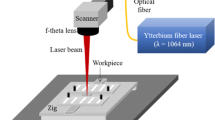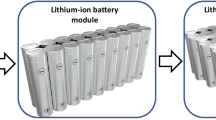Abstract
Li-ion batteries of higher capacities are fabricated in prismatic-shaped aluminium container-lid assembly and are laser weld for leak-proof design. Hermetic sealing of the Li-ion cells is essential for the consistent cycle life and capacity of the Li-ion cells. Laser welding of aluminium alloys poses several problems due to their high reflectivity and thermal conductivity, and several defects are commonly observed. Pore formation is one of the major defects observed in the laser welding of Li-ion cells causing cell leaking and deteriorating the electrochemical performance. The methodology for minimizing the pores, the reasons for their formation, and the optimization of laser welding parameters for minimizing these defects in prismatic Li-ion cells are discussed in this paper. The reasons attributing to pore formation have been categorized into contaminants, weld practices, laser parameter and discussed in detail. It is observed that pore formation from contaminants could be avoided by use of non-dyed anodized containers. Use of weld practices like slower weld speed of 0.1 mm/s ensures complete fusion. Ending the laser beyond the weld prevents the formation of craters containing pores. A slightly defocused beam of 500 µm spot size prevents spatter formation. Optimum laser energy of 12 J ensures complete depth of fusion preventing leaks due to through pores. Hermetic sealing of the prismatic cells with lower that 10−6 cc s−1 leak rate could be finally achieved by adopting these measures.










Similar content being viewed by others
References
Athanasopoulou L, Bikas H, Papacharalampopoulos A, Stavropoulos P, and Chryssolouris G, Int J Comput Integr Manuf 36 (2023) 334. https://doi.org/10.1080/0951192X.2022.2081363
König A, Nicoletti L, Schröder D, Wolff S, and Waclaw A, World Electr Veh J 12 (2021) 21. https://doi.org/10.3390/wevj12010021
Gitzendanner R L, Russell P G, Marsh C, and Marsh R A, J Power Sourc 81–82 (1999) 847. https://doi.org/10.1016/S0378-7753(99)00120-2
Yunlong Q, Sun Z, Spettmann C, Xing B, Xia Y, and Zhou Q, Int J Mech Sci 259 (2023) 108637. https://doi.org/10.1016/j.ijmecsci.2023.108637
Stock S, Hagemeister J, Grabmann S, Kriegler J, Keilhofer J, and Daub R, Electrochimica Acta 471 (2023) 143341. https://doi.org/10.1016/j.electacta.2023.143341
Orendorff C J, Electrochem Soc Interface, (2012) 61. https://doi.org/10.1149/2.F07122if
Wetzig D, Reismann M, Methods for Leak testing Li-ion batteries to assure quality with proposed rejection limit standards, SAE Technical paper 2020-01-0448 (2020). https://doi.org/10.4271/2020-01-0448
Stavropoulos P, Bikas H, Sabatakakis K, Theoharatos C, and Grossi S, Procedia CIRP 111 (2022) 784. https://doi.org/10.1016/j.procir.2022.08.129
Mercy T D, Rahul Sharma V F, Kaladharan K P, Kamalakaran S, and Aravamuthan G B, Mater Sci Forum 710 (2012) 155. https://doi.org/10.4028/www.scientific.net/MSF.710.155
Feng J, Zhang P, Yan H, Shi H, Qinghua L, Liu Z, Di W, Sun T, Li R, and Wang Q, Coatings 13 (2013) 1313. https://doi.org/10.3390/coatings13081313
Forsman T, Kaplan A F H, Powell J, and Magnusson C, Lasers Engg 8 (1999) 295.
Wang C, He D, Cui L, Guo X, Tan Z, and Wu X, Weld World 67 (2023) 2249. https://doi.org/10.1007/s40194-023-01579-3
Mercy T D, Rahul Sharma V F, and Kamalakaran Kaladharan K P, Mater Sci Forum 710 (2012) 632. https://doi.org/10.4028/www.scientific.net/MSF.710.632
Indhu R, Divya S, Tak M, and Soundarpandian S, Procedia Manuf 26 (2018) 495–502. https://doi.org/10.1016/j.promfg.2018.07.058
Rikka V R, Sahu S R, Tadepalli R, Bathe R, Mohan T, and Prakash R, J Mater Sci Eng B 6 (2016) 218. https://doi.org/10.17265/2161-6221/2016.9-10.002
Patwa R, Herfurth H, Heinemann S, Pantsar H, Regaard B, in Sheet Metal Welding Conf. XIV, Laser Welding and Process Monitoring Applications for Advanced Manufacturing of Batteries and Fuel Cells (2010)
Trinh L N, and Lee D, Metals 10 (2020) 842. https://doi.org/10.3390/met10060842
Kutsuna M, Kitamura S, Shibata K, Sakamoto H, and Tsushima K, Weld. World 50 (2006) 22. https://doi.org/10.1007/BF03266511
Sabatakakis K, Bourlesas N, Bikas H, Papacharalampopoulos A, and Stavropoulos P, Procedia CIRP 121 (2024) 222. https://doi.org/10.1016/j.procir.2023.09.251
Papaioannou C S, Bikas H, Souflas T, Stavropoulos P, in A Regression-Based Method For Reduced Order Modelling of Laser Welding Process, (eds) Galizia F G, Bortolini M A, Springer, (2023). https://doi.org/10.1007/978-3-031-34821-1_65
Stavropoulos P, Papacharalampopoulos A, Stavridis J, and Sampatakakis K, Inter J Adv Manuf Technol 110 (2020) 2991. https://doi.org/10.1007/s00170-020-05981-9
Kuo T Y, and Lin Y D, Mater Trans 48–2 (2007) 219. https://doi.org/10.2320/matertrans.48.219
Hafez Khalid M, Inter J Adv Manuf Techol 127 (2023) 1887. https://doi.org/10.1007/s00170-023-11665-x
Acknowledgements
The authors thank the Director NSTL, Visakhapatnam, for the kind support in carrying out the research work.
Author information
Authors and Affiliations
Corresponding author
Ethics declarations
Conflict of interest
The authors declare that they have no known conflict of interests/competing financial interests.
Additional information
Publisher's Note
Springer Nature remains neutral with regard to jurisdictional claims in published maps and institutional affiliations.
Rights and permissions
Springer Nature or its licensor (e.g. a society or other partner) holds exclusive rights to this article under a publishing agreement with the author(s) or other rightsholder(s); author self-archiving of the accepted manuscript version of this article is solely governed by the terms of such publishing agreement and applicable law.
About this article
Cite this article
Srinivas, M., Babu, P.N.S., Kumar, P.G. et al. Criticalities in the Laser Welding of Li-ion Batteries. Trans Indian Inst Met (2024). https://doi.org/10.1007/s12666-024-03295-y
Received:
Accepted:
Published:
DOI: https://doi.org/10.1007/s12666-024-03295-y




